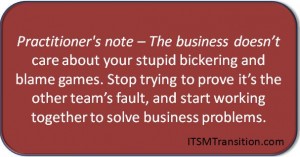Earth to IT: we don’t care about your stupid internal bickering and blame games. We expect you to work together to help us solve our business problems.
Your customers are under pressure to deliver results, and they don’t have patience for silos and tribalism. If you have a silo’d IT culture ~ it’s time to grow up and start working together as OneTeam.
We’re all in this together
A sense of belonging is a basic human need; to be part of ‘us’. And for there to be an ‘us’, there has to be a ‘them’. Unchecked, it creates an unhealthy ‘us versus them’ culture. It’s High School all over again. 
In sports there’s special teams – defense, offense, field goal team, kickoff return team. Each have a unique role, but all share the same goal – winning games.
It doesn’t matter that the return team executed flawlessly if the offense doesn’t score. The offense can score lots of points, but if the defense gives up more goals, the game is lost.
It’s nauseating to see IT teams nitpick each other to pieces in a pathological competition to be ‘better’ than other teams. The sky’s the limit in blame storming and dirty politics to ensure other teams’ faults are held against them, and their own are expertly hidden.
But, here’s the deal. Your customers are the ones who suffer, and they know it.
Earth to IT: we don’t care about your stupid bickering and blame games. Stop trying to prove it’s the other team’s fault, and start working together to help us solve our business problems.
Ever hear the saying ‘think global, act local’? Well, in IT it means first understanding the big picture, what our customers need, and then working to the best of my ability in my role to help the team achieve the goal.
It’s a concept I’ve come to call simply ‘OneTeam’.
Thinking OneTeam
It might sound cliche, but OneTeam is a journey not a destination. It’s a culture; a way of thinking. It expands the borders of who’s “us”. It redefines what ‘success’ looks like.
OneTeam:
- Fully committed to serving the customer
- Focuses on the success of the entire team
- Different roles; same goals
- Respectful of colleagues at every level
- Asks “is this in the best interest of the customer?”
- Takes personal ownership in the success of others
- Refuses to speak poorly of others; encourages personal accountability
- Does what’s best for the whole team rather than myself or my unit
- Asks “how can I increase my contribution to the team”
- Respectfully challenges behaviors that build walls
- Peers and colleagues are my team mates; we are not in competition or conflict
- Asks “how can we make this better for the customer?”
- Trusts colleagues
- Actively builds connections throughout the organization (both IT and business)
- Understands how my work supports the goals of the organization
- Is always willing to help others
- Is mindful of own weaknesses
- Owns up to mistakes, continually improves
- Invests in own skills; strives to increase personal contribution to the team
- Builds a faultless culture
- Removes language like “not my job” and “my area is fine” from the culture
OneTeam in action
OneTeam has some implications that may not be obvious:
- Processes cut across organizational boundaries. The idea of other groups having a say in how individual teams perform their part can be awkward and create friction.
The concept of process ownership needs to be communicated clearly and consistently. Roles and responsibilities need to be understood. RACI charts can be helpful. Don’t underestimate the cultural shift from vertical thinking to horizontal. (See IT Value is Created Horizontally) - The measure of a process is how well it performs it’s purpose – the outcomes. There is no place for “we did our part, it’s their fault”.
Traditional management is based on knowing what’s expected of my group, and having the autonomy do it.
But in some cases, maximizing the efficiency of a single group will decrease the efficiency of the overall process. - Great companies have empowered employees. But there’s a big difference between empowerment and silo creation. Make sure there’s a clear connection between the organization’s goals and the work IT staff do day to day.
Mark Thomas shows how it’s done with Goals Cascade (see Aligning IT goals using the COBIT5 Goals Cascade.) - Avoid process metrics that support “we’re better than them” thinking. Friendly rivalries are one thing, but do not allow metrics to become ammunition to use against others.
- When things go wrong, it’s easy to focus on the ‘obvious’ failings of others. OneTeam expects everyone to identify things their team did that may have contributed, and look for ways to improve.
- It starts at the top. IT managers who work together as OneTeam, create a winning culture. Leadership must live OneTeam and lead by example.



One comment on „OneTeam”